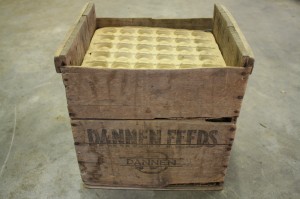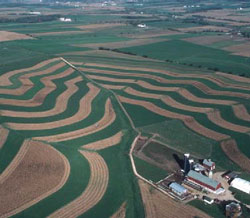 A new USDA study shows that farmers using combinations of erosion-control and nutrient-management practices on cultivated cropland are reducing losses of sediment, nitrogen and phosphorous from farm fields and decreasing the movement of these materials to the Great Lakes and their associated waterways.
A new USDA study shows that farmers using combinations of erosion-control and nutrient-management practices on cultivated cropland are reducing losses of sediment, nitrogen and phosphorous from farm fields and decreasing the movement of these materials to the Great Lakes and their associated waterways.
“The Great Lakes Conservation Effects Assessment Project (CEAP) study confirms that good conservation planning and implementation have reduced loadings of sediment and nutrients to waterways throughout the region,” Agriculture Secretary Tom Vilsack said. “The Administration appreciates the actions of every farmer who is stepping up to implement conservation practices, protect vital farmlands and strengthen local economies. At the same time, we also see opportunities for even further progress.”
 The CEAP study, prepared by USDA’s Natural Resources Conservation Service (NRCS), estimates that the use of conservation tillage and other conservation practices has resulted in a 50 percent decline in sediment entering rivers and streams, along with 36 and 37 percent declines, respectively, in phosphorus and nitrogen loading.
The CEAP study, prepared by USDA’s Natural Resources Conservation Service (NRCS), estimates that the use of conservation tillage and other conservation practices has resulted in a 50 percent decline in sediment entering rivers and streams, along with 36 and 37 percent declines, respectively, in phosphorus and nitrogen loading.
USDA-NRCS Chief Dave White outlined four major conclusions from the study. “First is that conservation works. Second, we also know that more needs to be done and primarily in this region that is nutrient management, particularly sub-surface nitrogen and phosphorus,” he said. “Third is that systems of conservation practices work best. And the fourth takeaway is that we can have a much greater impact with our programs if we target our resources to those acres where the need is greatest.”
The study covers nearly 174,000 square miles – the entire U.S. side of the Great Lakes Region – including nearly all of Michigan and parts of Illinois, Indiana, Minnesota, New York, Ohio, Pennsylvania and Wisconsin.
The Conservation Technology Information Center Conservation in Action Tour this year took place in the northwest Ohio region of the Lake Erie watershed and we got some interesting insight from state NRCS staff in that area.

 Twenty years ago, Al Myers, founder of Ag Leader Technology, began manufacturing the Yield Monitor 2000, a revolutionary on-the-go yield monitoring system. Little did he know that today, the yield monitor would be the centerpiece of the precision farming practice and the Yield Monitor 2000 would become the benchmark to which all other manufacturers attempt to match.
Twenty years ago, Al Myers, founder of Ag Leader Technology, began manufacturing the Yield Monitor 2000, a revolutionary on-the-go yield monitoring system. Little did he know that today, the yield monitor would be the centerpiece of the precision farming practice and the Yield Monitor 2000 would become the benchmark to which all other manufacturers attempt to match. 
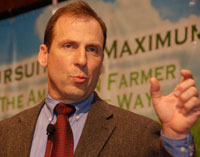 As farmers finish the harvest this season and begin to prepare fields for next year, it is important that they look at nitrogen management with a systems approach, according to
As farmers finish the harvest this season and begin to prepare fields for next year, it is important that they look at nitrogen management with a systems approach, according to 
 The
The  Many farmers rely on GPS for precision agriculture. This includes using GPS for accurate mapping of field boundaries, roads and irrigation systems; for precision planting; and for targeting the application of fertilizer and chemicals that combat weeds and crop diseases. GPS also allows farmers to work in their fields despite low-visibility conditions such as rain, dust, fog and darkness.
Many farmers rely on GPS for precision agriculture. This includes using GPS for accurate mapping of field boundaries, roads and irrigation systems; for precision planting; and for targeting the application of fertilizer and chemicals that combat weeds and crop diseases. GPS also allows farmers to work in their fields despite low-visibility conditions such as rain, dust, fog and darkness.
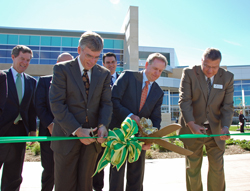
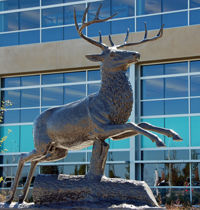 One of the highlights of the ceremony was the unveiling of the new building’s crowning centerpiece that stands at the main entrance – one of the original John Deere deer statues that were first made some time around the early 1900s. Regional controller Mike Snyder explained that an unknown number of the statues were commissioned by the son of John Deere in 1893 to be made by the W.H. Mullins Company of Salem, Ohio. “The statue is made out of hand stamped copper sheets, riveted and welded together and mounted on a steel frame,” he said, noting that Charles Deere saw the statue at the 1893 World’s Fair in Chicago and liked it so much he decided he wanted enough of them to be placed at every John Deere branch office and factory in the country. “Over the years, the importance faded and some were lost but recently company CEO Hans Becherer began a program to find and restore as many of them as possible.” The statue at the Olathe office is one of only 14 the company currently has.
One of the highlights of the ceremony was the unveiling of the new building’s crowning centerpiece that stands at the main entrance – one of the original John Deere deer statues that were first made some time around the early 1900s. Regional controller Mike Snyder explained that an unknown number of the statues were commissioned by the son of John Deere in 1893 to be made by the W.H. Mullins Company of Salem, Ohio. “The statue is made out of hand stamped copper sheets, riveted and welded together and mounted on a steel frame,” he said, noting that Charles Deere saw the statue at the 1893 World’s Fair in Chicago and liked it so much he decided he wanted enough of them to be placed at every John Deere branch office and factory in the country. “Over the years, the importance faded and some were lost but recently company CEO Hans Becherer began a program to find and restore as many of them as possible.” The statue at the Olathe office is one of only 14 the company currently has. 

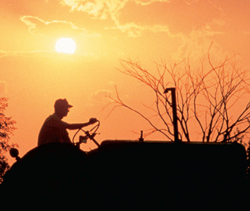 The report heralds that agriculture is
The report heralds that agriculture is 